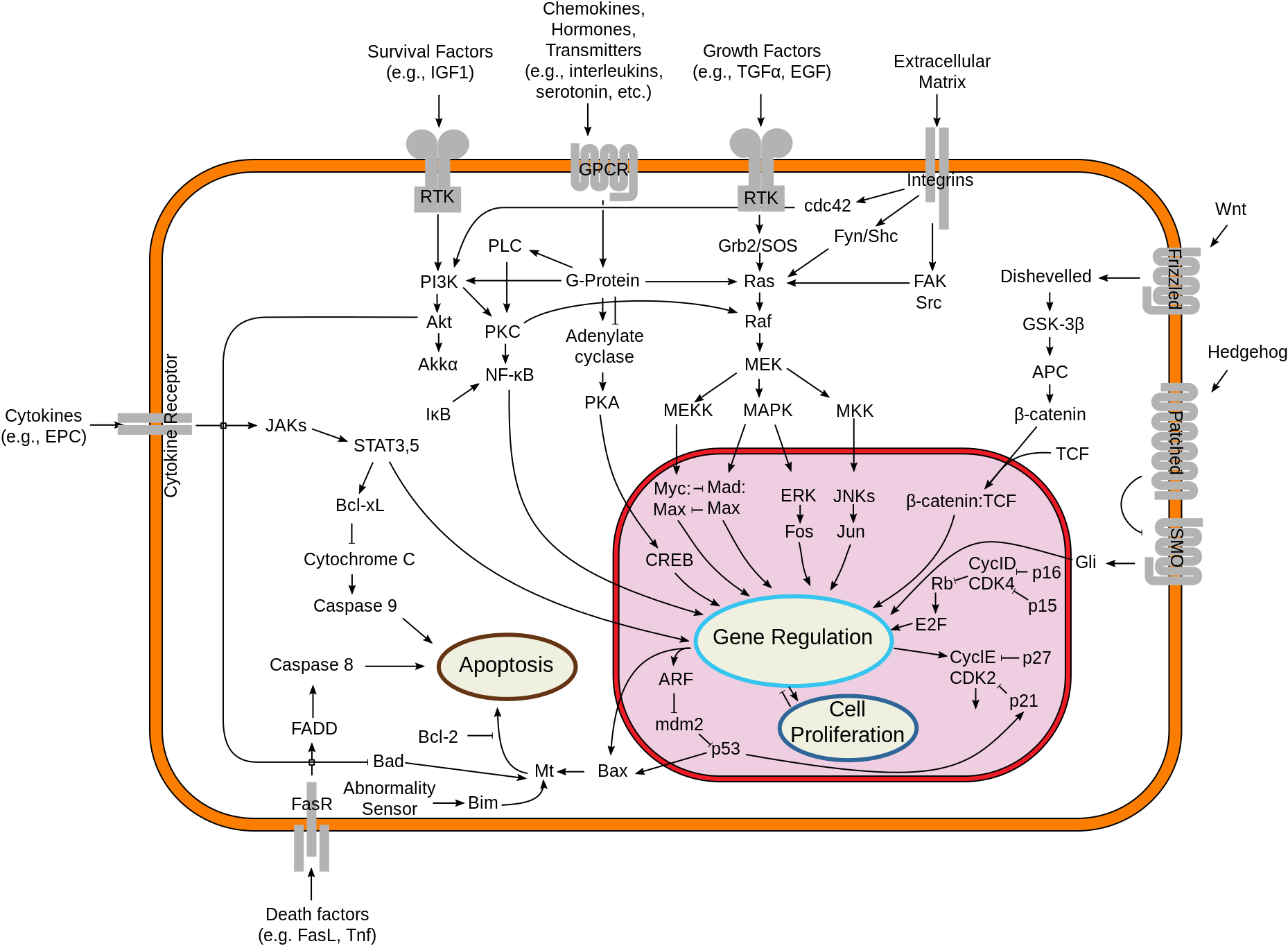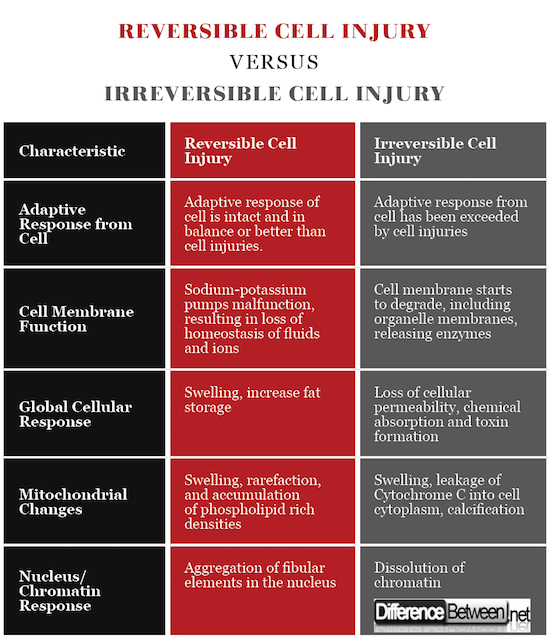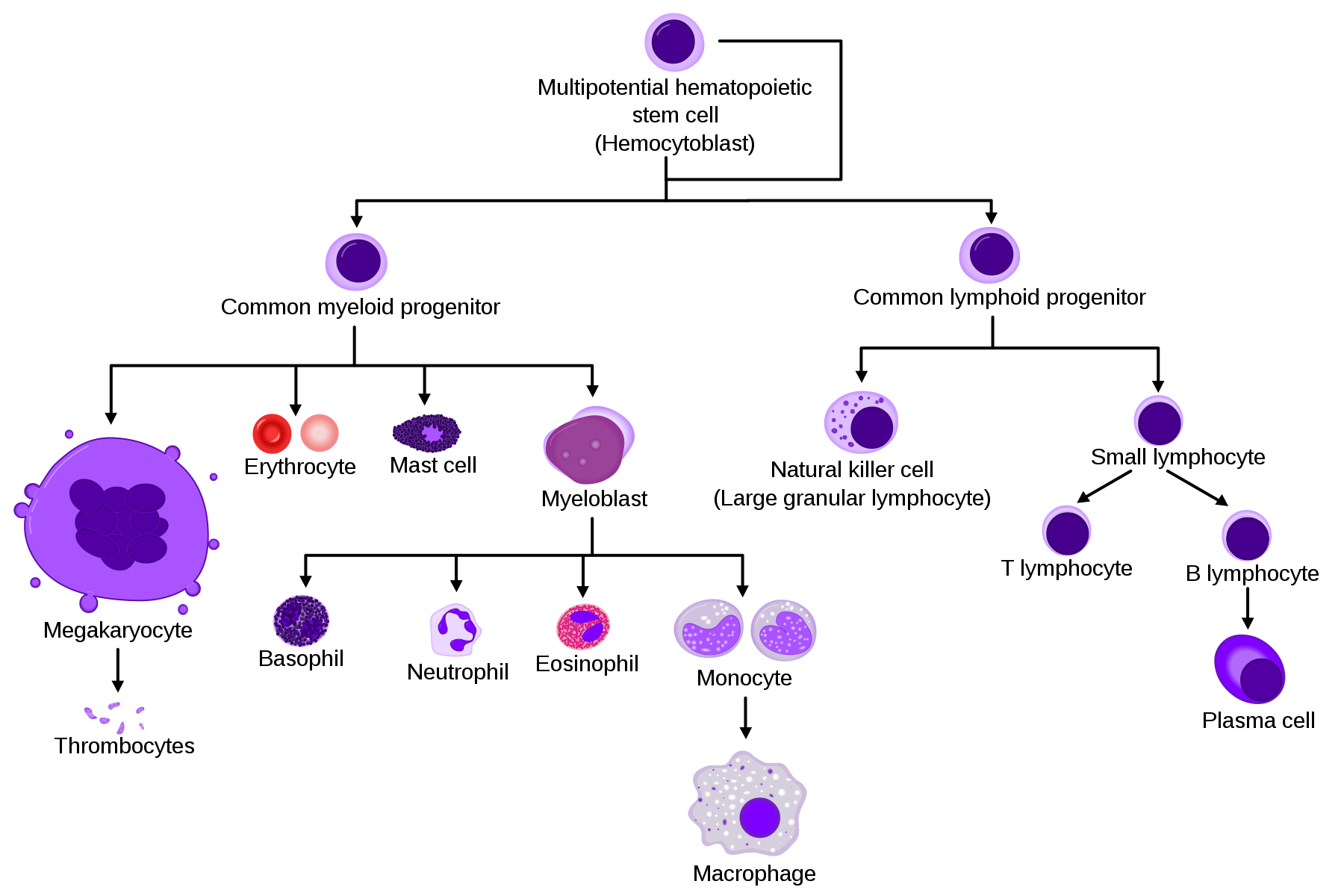Difference Between Reversible and Irreversible Cell Injury
Cell injury may be a reversible or irreversible process. In reversible cell injury, cells can recover to their normal function. In irreversible cell injury, cells undergo injury so severe that cell death and, ultimately, necrosis of tissue occur.
While both reversible and irreversible cell injury signal a noxious stimulus from the environment on the cell, each injurious state can be classified by the type of injury, the severity of injury, the duration of injury, and the type of cell being injured. Of these, duration and type of injury are the differentiating factors between reversible and irreversible cell injury.
Depending on cell type, the duration towards the so-called “point of irreversibility” (i.e., the point where the cell injury becomes irreversible) varies widely. However, there are established causes of cell injury including: hypoxia (oxygen deficiency), ischemia (lack of blood flow), physical and mechanical injury, chemical injury, radiation, biological injury (viruses, pathogens), and nutritional injury.

What is Reversible Cell Injury?
Reversible cell injury, also known as RCI, is a cellular injury with the hallmark of morphological changes to the cell. These changes can be reversed if the injurious stimulus is removed. Identifiable characteristics of a cell undergoing reversible cell injury are reduced oxidative phosphorylation, downregulation of adenosine triphosphate (ATP) production, and swelling of the cell caused by changes in ion concentrations within the cell. Other global responses can be see as well.
One global response, cellular swelling, is common of reversible cell injury. This occurs when cells are unable to maintain homeostasis of ions and other fluids, which is a result of misfunctioning ion channels in the cell membrane. Although hard to detect on the single cell level, cellular swelling if fairly common at the organ and tissue level. Cellular swelling is pharmacologically reversible.
Another global response of reversible cell injury is fat storage change. Fat storage is evidence that cell injury occurs because one observes large lipid vacuoles accumulating in the cytoplasm during hypoxic and chemical injury. However, only cells that are dependent upon fat metabolism see fluctuations in fat storage.
Reversible cell injury is characterized by the following pathology:
- Decreased supply of oxygen due to decreased production of ATP.
- Increase in cellular glycolysis to increase ATP stores
- Decrease in cellular glycogen; decrease in intracellular pH.
- Decrease in ATP leads to accumulation of sodium and diffusion of potassium, leading to cellular swelling.
- Continued oxygen depletion leads to cellular “blebbing” or malformations of the plasma membrane.
What is Irreversible Cell Injury?
Irreversible cell injury is injury to a cell that also causes morphological changes to the cell, albeit more permanent and often, more internal to the inner machinery of the cell. If the injurious stimulus is not removed after a long period of time, for example in chronic viral infections, chemical exposures, or an internal response that is intentional (i.e., an immunological response), irreversible injury and ultimately cell death can occur.
Irreversible cell injury is similar to reversible cell injury in that both involve some external, harmful stimulus. Likewise, internal mechanisms at the cellular level take place, whether it be blebbing like in reversible cell injury, or mitochondrial Cytochrome C leakage that triggers cell death like in irreversible cell injury.
Irreversible cell injury is characterized by the following pathology:
- Mitochondrial swelling
- Lysosomal swelling
- Damage to plasma membrane and lysosomal membranes that cause enzyme leakage
- Increased acidosis in the cellular environment
Difference Between Reversible Cell Injury and Irreversible Cell Injury
1. Duration of Injury in Reversible and Irreversible Cell Injury
Reversible cell injury can usually be stopped by removing or destroying the injurious stimulus, while irreversible cell injury has progressed past a point of “no return.”
2. Type of Injury involved in Reversible and Irreversible Cell Injury
Reversible cell injury is usually the result of the beginning stages of lack of oxygen, also known as hypoxia, or ischemia, the lack of blood flow to cells, while irreversible cell injury involves more insidious agents such as viruses, immunological responses, or genetic disadvantages.
3. Cellular Response for Reversible and Irreversible Cell Injury
Reversible cell injury results in cellular swelling, fat accumulation, and cellular “blebbing” or protrusions at the cell membrane. Irreversible cell injury results in acidosis of the cellular environment, destruction of key organelles, and damage to membranes.
4. Tissue Response to Reversible vs Irreversible Cell Injury
Reversible cell injury leads to noticeable swelling and increase in surface areas at the tissue levels, while irreversible cell injury leads to necrosis and cell death.
5. Recovery
Reversible cell injury is pharmacologically treatable and can result in recovery, while irreversible cell injury results in permanent cell loss and death.
Reversible Cell Injury vs. Irreversible Cell Injury: Comparison Table

Summary of Reversible Cell Injury versus Irreversible Cell Injury
- Both reversible and irreversible cell injury are types of injuries to cells that involve some sort of injurious stimulus, whether that be chemical, biological, hypoxic, etc. Both types of cell injuries elicit unique cellular responses.
- Reversible cell injury is, by definition, reversible if the stimulus is removed before a certain duration of time. This duration, i.e., the point of irreversibility, varies amongst cell types.
- Irreversible cell injury results in cellular apoptosis or programmed cell death and necrosis of tissue.
- Reversible cell injury leads to global swelling and change in fat storage, while keeping most structural elements of the cell intact.
- Irreversible cell injury leads to mitochondrial and cell membrane destruction as well as enzymes being released into the cytoplasm, which can be toxic for the cell.
- The pathologies of the two injuries initially share the same path. At some point, injuries proceed from reversible to irreversible.
- Difference Between Basal Cell and Squamous Cell Carcinoma - July 12, 2018
- Difference Between Hepatitis and Cirrhosis - May 22, 2018
- Difference Between Reversible and Irreversible Cell Injury - May 12, 2018
Search DifferenceBetween.net :
 Email This Post
: If you like this article or our site. Please spread the word. Share it with your friends/family.
Email This Post
: If you like this article or our site. Please spread the word. Share it with your friends/family.
2 Comments
Leave a Response
References :
[0]Cobb, J. P., et al. "Mechanisms of cell injury and death." British Journal of Anaesthesia 77.1 (1996): 3-10.
[1]Kumar, Vinay, Abul K. Abbas, Nelson Fausto, Stanley L. Robbins, and Ramzi S. Cotran. Robbins and Cotran Pathologic Basis of Disease. Philadelphia: Elsevier Saunders, 2005. Print.
[2]Smuckler, Edward A., and Jacqueline L. James. "Irreversible cell injury." Pharmacological Reviews 36.2 (1984): 77S-91S.
[3]Image credit: https://en.wikipedia.org/wiki/Cell_death#/media/File:Signal_transduction_pathways.svg
[4]Image credit: https://en.wikipedia.org/wiki/Haematopoiesis#/media/File:Hematopoiesis_simple.svg



Thank you for this
Thank you